No, I haven’t seen Avatar yet. I haven’t seen Alvin and the Chipmunks: The Squeakquel, either, so this whole endeavor could be a fool’s errand. Still, onward. Favorite films of the year, listed in order seen.
Up
The Hurt Locker
In the Loop
Julia
Inglourious Basterds
District 9
The Informant!
A Serious Man
Anvil!: The Story of Anvil
The Damned United
Two exclamation points. That’s a record.
Cinematic highlight of the year: same as always, baby. Noir City. 2010’s installment is coming up fast.
And a holdover from last year’s list, Thrillers More People Should Have Seen. All currently available on video.
Just Another Love Story. Classic noir elements repurposed and updated in a twisty film from Denmark.
The Limits of Control. Calling Jim Jarmusch’s movie a thriller may be something of a stretch. I’m not sure what happens in it. I’m not sure anything happens in it. Simply allow its beauty to wash over you, though, and you’ll be alright.
The Merry Gentleman. I’m a fan of Michael Keaton’s directorial debut. But it will now always have a special place in my heart. Why? Because it made me big in Canada.
A Perfect Getaway. David Twohy is the last of the old-school genre storytellers (Pitch Black, Below). The slow build-up and the lead character being a screenwriter only add to the meta-fun. If this movie were French, it would be a cult classic praised to the rafters by hipster critics. But because it was filmed in Hawaii and stars recognizable actors like Steve Zahn and Timothy Olyphant, it’s fated to be the best movie nobody saw this year.
Thursday, December 31, 2009
The Good Stuff: Films of 2009
Tuesday, December 29, 2009
The Good Stuff: Books of 2009
I’ll keep the preamble to a minimum. The books are listed in the order I read them. More detailed posts can be found here.
Favorite crime fiction:
Beat the Reaper, Josh Bazell
Safer, Sean Doolittle
American Rust, Philipp Meyer
No More Heroes, Ray Banks
Bury Me Deep, Megan Abbott
Dark Places, Gillian Flynn
The Jerusalem File, Joel Stone
The Ghosts of Belfast, Stuart Neville
Pariah, Dave Zeltserman
Losers Live Longer, Russell Atwood
Favorite not-crime fiction:
How I Became a Famous Novelist, Steve Hely
Hummingbirds, Joshua Gaylord
The Financial Lives of the Poets, Jess Walter
Bonus Categories:
2008 novel that would have been on this year’s list and could have been on last year’s had I read it in time: The Age of Dreaming, Nina Revoyr
2010 novel that would have been on this year’s list and will probably be on next year’s: Print the Legend, Craig McDonald
Favorite novels that were new to me in 2009: The Red Right Hand, Joel Townsley Rogers (1945) and Adios, Scheherazade, Donald E. Westlake (1970). Again, a thousand thanks to Duane Swierczynski for introducing me to the latter.
Favorite non-fiction:
The Complete Game, Ron Darling
Methland, Nick Reding
L.A. Noir, John Buntin
And finally, the best book I read in 2009 regardless of genre or year of publication is Moneyball: The Art of Winning an Unfair Game, by Michael Lewis (2003). I’ll go you one better. This book – about economics, business, mathematics, baseball and life – goes on the short list of the greatest books I’ve ever read, along with Dino, Nick Tosches’ biography of Dean Martin, and The Hardy Boys Detective Handbook. Illustrious company indeed.
Wednesday, December 23, 2009
Miscellaneous: It’s A Shane Black Christmas (Redux)
There I am at my favorite watering hole, talking with the staff, when the subject of Christmas movies is raised.
First suggestion, not made by me: the traditional double-bill of Die Hard and Die Hard II: Die Harder.
Thus giving me the tenor of the conversation. This is not the time, perhaps, to mention Remember the Night and Holiday Affair, two overlooked films (with noir connections!) that Turner Classic Movies has labored to turn into Yuletide staples. Although a mention of Blast of Silence, full of Wenceslas wetwork, might not be out of the question.
So I lobby for my own Christmas favorite, The Ref. And then observe, not for the first time, that the entire oeuvre of Shane Black – Lethal Weapon, The Last Boy Scout, The Long Kiss Goodnight, and Kiss Kiss Bang Bang – is set at the most wonderful time of the year.
Therefore, as you venture out for that last round of shopping, I offer, by popular demand, what has become a VKDC tradition. (“By popular demand” meaning Rosemarie asked, “Why haven’t you posted this yet?” And she did write most of it.) Here, once again, is Shane Black’s 12 Days of Christmas. Record your church group performing this and we’ll post the video here!
Twelve cars exploding
Eleven extras running
Ten tankers skidding
Nine strippers pole-ing
Eight Uzis firing
Seven henchmen scowling
Six choppers crashing
Five silver Glocks
Four ticking bombs
Three hand grenades
Two mortar shells
And a suitcase full of C-4
God bless us, everyone. Or else.
Tuesday, December 22, 2009
Book: Alone, by Loren D. Estleman (2009)
Third consecutive book about Hollywood in one form or another. I don’t plan these things, people. They simply happen.
Any list of crime fiction’s premier stylists would have to include Loren Estleman. His insouciant prose has brightened up many a dark book, but it fizzes like champagne in his lighter tales about Valentino, the UCLA archivist whose business cards read “film detective.”
A rare treasure is dangled before Valentino by a university donor: the only extant print of How Not to Dress, the brief promotional film marking the first screen appearance of Greta Garbo. But before light strikes frame one, Valentino finds himself amidst blackmail and murder. He’s got other problems. A crooked building inspector has rousted him from the movie palace he’s attempting to restore to its former glory, leaving him at the house and the throat of his closest friend and colleague. And there’s his budding romance with an LAPD forensics expert.
Alone is a confection, and a good one. Estleman has struck upon an ingenious method for writing about classic Hollywood in a contemporary setting. I will say that the jabs at current films are out of character and occasionally wrong; Brian De Palma’s name is spelled incorrectly, and Pulp Fiction is misquoted in the author’s afterword. It’s important for curmudgeons to get the details right. Still, it’s a minor quibble. Go. Buy. Read.
Sunday, December 20, 2009
Book: L.A. Noir, by John Buntin (2009)
John Buntin started with a real-world question steeped in fiction: how did the LAPD of L.A. Confidential become the LAPD of Dragnet? Answering it produced a rich, lively work of history that reads like a pulp novel from the era it covers.
L.A. Noir is a joint biography of William H. Parker, the chief who made the department what it is today, and Mickey Cohen, the kind of gangster who could only flourish in Southern California. But it’s also a portrait of what Buntin calls “America’s Most Seductive City” from the 1920s through the Watts riots. Like any first-rate Hollywood production it features a slew of cameos, including Billy Graham and Ben Hecht, Lana Turner and Johnny Stompanato.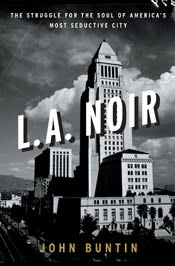 Some of the most interesting material involves Dragnet and how Parker used the show in all its forms to remold the LAPD’s image. It’s hard to overstate Dragnet’s popularity; at one point it was the most watched TV series in America after I Love Lucy while still drawing a huge radio audience. The next step, obviously, was a feature film. At the time of production, the LAPD’s more invasive tactics were being challenged in the courts; in instances where the department couldn’t get permission to place wiretaps, it would simply break into a suspect’s home, install a dictograph, and record conversations that way. Parker offered Dragnet’s Jack Webb a sensational case file to serve as the basis for the film, which ended up defending the techniques then under siege. The 1954 Dragnet movie, by the way, is uncommonly grim and brutal. Even for Jack Webb. It’s kind of great. It’s not currently on video, but it is available via streaming on Netflix.
Some of the most interesting material involves Dragnet and how Parker used the show in all its forms to remold the LAPD’s image. It’s hard to overstate Dragnet’s popularity; at one point it was the most watched TV series in America after I Love Lucy while still drawing a huge radio audience. The next step, obviously, was a feature film. At the time of production, the LAPD’s more invasive tactics were being challenged in the courts; in instances where the department couldn’t get permission to place wiretaps, it would simply break into a suspect’s home, install a dictograph, and record conversations that way. Parker offered Dragnet’s Jack Webb a sensational case file to serve as the basis for the film, which ended up defending the techniques then under siege. The 1954 Dragnet movie, by the way, is uncommonly grim and brutal. Even for Jack Webb. It’s kind of great. It’s not currently on video, but it is available via streaming on Netflix.
If you’re a fan of Chandler, Chinatown, or Ellroy, L.A. Noir is essential reading. It’s one of the best books of the year.
Friday, December 18, 2009
Book: Hollywood Moon, by Joseph Wambaugh (2009)
Gaze on in wonder as I split hairs.
In writing, there’s formula and there’s formulaic. Formula can be good. Formulaic is always bad. With formulaic writing, you know exactly what you’re going to get. With a formula, you get exactly what you want.
You know who’s got a formula? Coca-Cola. And whenever you crave that particular flavor, you can crack open a can knowing that thirst will be quenched.1
You know who else has a formula? Joseph Wambaugh in his Hollywood books. Like every good recipe, it’s simple and satisfying.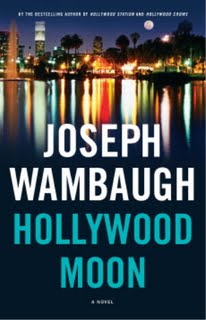 Take the regular roster of LAPD officers who work the mean streets of Hollywood – the neighborhood, not the state of mind. The surfer cops Flotsam and Jetsam. Nate Weiss, always ready with his SAG card. Toss in some newcomers to the patrol, like tough single mom/sergeant-to-be Dana Vaughn. Find the right balance of humor and heartbreak.
Take the regular roster of LAPD officers who work the mean streets of Hollywood – the neighborhood, not the state of mind. The surfer cops Flotsam and Jetsam. Nate Weiss, always ready with his SAG card. Toss in some newcomers to the patrol, like tough single mom/sergeant-to-be Dana Vaughn. Find the right balance of humor and heartbreak.
Add in some criminals, life-size opportunists and screw-ups. The lineup in Hollywood Moon includes a failed actor-turned-master-of-disguise putting in long days on an identity theft scam; the mastermind he lives in fear of, also his wife; a pair of runners wising up to the operation; and a borderline psychotic teenager desperate for an escape. Slowly turn up the heat. Stand back and watch things explode.
You have to season to taste. There’s too much of the surfers in this outing – a little of them goes a long way – but the heavies are the strongest yet. Wambaugh could write one of these books a month and I’d read it.
1Sometimes a successful formula can work against you. I had my first Mexican Coke recently. I didn’t know it when I bought it. I thought, “Cool! A glass bottle!” and only when I opened it did I notice the label was in Spanish. I didn’t like it. It tasted fine. It just didn’t take like Coke, which is what I wanted.
Wednesday, December 16, 2009
Movie: He Ran All The Way (1951)
The last John Garfield post started an interesting exchange with fine novelist/friend of the site Ed Gorman. Ed suggested that Garfield’s persona might not have worn as well as other noir stars because it can’t be easily reduced. Think of Robert Ryan and you think of that peculiar combination of rage and sorrow. Dana Andrews is melancholy. Bogart is coolness under pressure. Lee Marvin is menace.
As usual, Ed’s onto something. Garfield’s mercurial presence was used well in a number of strong films – The Postman Always Rings Twice, Body and Soul, Force of Evil – but not one that you could point to and say, “That is John Garfield.” Plus there’s something boyish about him. Ryan, Bogart, Marvin – these are men, fully grown and set in their ways. Garfield still seemed malleable. I meant it when I said Garfield cast a long shadow, because in an era with far too few men onscreen, Garfield is the best model we’ve got.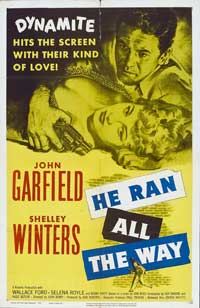 His youthful energy allowed him to play a role he was too old for in what would be his final film, He Ran All The Way. He’s a smalltime, slow-witted criminal still living with his mother (the pitiless Gladys George). After panicking during a payroll heist and killing a police officer, he picks up Shelley Winters, goes home with her, and takes her family hostage.
His youthful energy allowed him to play a role he was too old for in what would be his final film, He Ran All The Way. He’s a smalltime, slow-witted criminal still living with his mother (the pitiless Gladys George). After panicking during a payroll heist and killing a police officer, he picks up Shelley Winters, goes home with her, and takes her family hostage.
The movie is a forerunner of the home invasion genre that took root during the post-war suburban boom. Like other films of the type, there are moments that strain credulity. (“Rush him now! Take the gun!”) But it’s also charged with an uncommon mood of paranoia, even doom. Director John Berry and cinematographer James Wong Howe keep the camera uncomfortably close to Garfield’s desperate face, using scenery to trap him in the frame. The actor takes care of the rest, right up to the closing shot. It’s our last image of John Garfield. He died of a heart attack at age 39, haunted by charges of being a Communist sympathizer.
The latest issue of the Film Noir Foundation’s Noir City Sentinel includes a terrific article by Jake Hinkson that looks at He Ran All The Way as a blacklist case study. You can read it online now.
Upcoming: Noir City Northwest
Looks like I’ll be seeing He Ran All The Way again shortly, the way it was meant to be seen. The schedule for 2010’s Noir City Northwest is up. Eddie Muller’s dark carnival hits SIFF Cinema after its run in San Francisco.
This year’s theme is Lust & Larceny. It’s a doozy of a line-up. I’ve seen six of the fourteen films before, only one of them (Pitfall) on the big screen. I’m eager to catch the newly restored print of the crackling Cry Danger, while Rosemarie can’t wait for the aptly titled Larceny, starring John Payne and Dan Duryea as dandy grifters. Come that week in February you know where I’ll be, endeavoring to bring you the coverage you’ve come to expect.
Monday, December 14, 2009
Book: Print the Legend, by Craig McDonald (2010)
Other websites may be offering lists of 2009’s finest1, but around here we’re more forward thinking. Permit me instead to tease you with a word about one of the best books you’ll read next year2.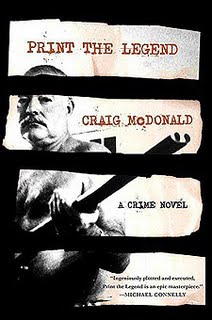 Print the Legend is the third novel by Craig McDonald featuring Hector Lassiter, the man who lives what he writes and writes what he lives. And it’s a full-on tour de force.
Print the Legend is the third novel by Craig McDonald featuring Hector Lassiter, the man who lives what he writes and writes what he lives. And it’s a full-on tour de force.
Hec’s longtime friend Ernest Hemingway is four years in the ground when Hec consents to address an Idaho conference devoted to Papa’s life and work. But Hec’s got more to reckon with than a speech. There are his own unsettled feelings about his compatriot. And the dogged efforts of a scholar intent on proving that Hemingway’s suicide was in fact a coldblooded murder committed by Papa’s wife Mary – a theory that Hec can’t easily dismiss. Plus Hec’s burgeoning affection for said scholar’s pregnant wife. Not to mention Mary Hemingway’s own plans for Papa’s legacy and Hec’s role in it. And above all, the twisted machinations of Donovan Creedy, the hack novelist, government operative and dirty tricks specialist with shades of E. Howard Hunt.
Not many authors would dare to write a missing chapter from Hem’s A Moveable Feast. Fewer would pull it off as McDonald does here. He then follows up with a beautifully structured section jumping between the POVs of his five major characters at a single treacherous meeting. Late in the book there’s an extended description of let’s say physical courage that Papa himself would approve of. Me, I went pale just reading it.
Print the Legend moves with the intensity of a fever dream, driven by Hec’s zeal for life. If the book has a weakness, it’s the notion that Creedy’s abstract plan has a hope in hell against the force of nature that is Hector Lassiter.
Why am I tormenting you with praise for a book that doesn’t come out until February? Because McDonald offers a few tantalizing hints of the next book in the series, set in 1958 Nashville, and that’s at least another year away. It’s only fair that we all suffer together.
1Don’t worry. Such a post is coming.
2Yeah, FTC, I got a review copy. Whatcha gonna do about it?
Thursday, December 10, 2009
On The Web: Crimespree Cinema
The gang over at Crimespree Cinema has asked some big names to contribute 5 favorites for 2009 – film, TV or DVD. Somehow I slipped through their defenses. My picks are up now.
Sort Of Related: The Fallen Sparrow (1943)/Nobody Lives Forever (1946)
John Garfield may not have the same level of recognition as noir icons like Humphrey Bogart and Robert Mitchum, and the rediscovery of other names from the era like Richard Conte has allowed him to get lost in the cracks. But Garfield’s shadow may extend the furthest. The type of character he often portrayed – streetwise but fundamentally decent, a boyish tough guy who could be tamed – is a standard today. Put it this way: alone among his contemporaries, Garfield could have played either Matt Damon’s role or Leonardo DiCaprio’s in The Departed, and been brought back to read for Mark Wahlberg’s into the bargain. Watching two lesser known Garfield films with serious crime fiction pedigrees brought home the potency of that persona.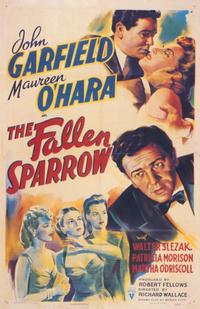 In The Fallen Sparrow, based on a novel by Dorothy B. Hughes (Ride the Pink Horse, In a Lonely Place), Garfield plays a veteran of the Spanish Civil War held prisoner by the Nazis. He’s freed in 1940 and returns to New York only to discover the Germans are still shadowing him while he delves into the murder of the childhood friend who delivered him from harm. The first third of the movie is rough sledding, a muddle with too many characters in a convoluted backstory. And may the gods of cinema take pity on you if you can’t figure out who the villain of the piece is. (Hint: The person it couldn’t be, because that’d be too obvious? Yeah, that’s who it is.)
In The Fallen Sparrow, based on a novel by Dorothy B. Hughes (Ride the Pink Horse, In a Lonely Place), Garfield plays a veteran of the Spanish Civil War held prisoner by the Nazis. He’s freed in 1940 and returns to New York only to discover the Germans are still shadowing him while he delves into the murder of the childhood friend who delivered him from harm. The first third of the movie is rough sledding, a muddle with too many characters in a convoluted backstory. And may the gods of cinema take pity on you if you can’t figure out who the villain of the piece is. (Hint: The person it couldn’t be, because that’d be too obvious? Yeah, that’s who it is.)
But Sparrow fascinates for several reasons. There’s a troika of interesting women, foremost among them Maureen O’Hara as an ice princess who only begrudgingly thaws. But it’s Garfield’s work as a proto-Manchurian Candidate, still suffering the effects of torture at the hands of his captors, that compels. The film’s MacGuffin is also just right, a mixture of nobility and stubbornness that suits Garfield to a T.
By comparison, Nobody Lives Forever is light entertainment. W.R. Burnett is credited as writing the original screenplay, but it’s adapted from a story serialized in Collier’s in 1943. Garfield is Nick Blake, recovered from his WWII service and ready to resume his grifting career. He lights out for the coast and sets his sights on a rich widow, but when he falls for her for real he has to deal his partners out.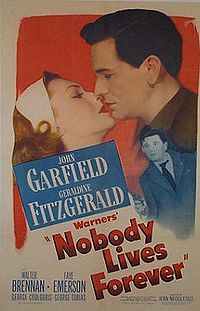 Nothing in Nobody is even remotely surprising, but the machinery is so finely assembled by Burnett and director Jean Negulesco that you’re happy to take a ride to a familiar destination if only to enjoy the scenery. George Coulouris chafes nicely as an aging con man who can’t accept that he’s no longer a pretty boy. Retro crush Faye Emerson is on hand as a bad girl, matched forehead for lovely forehead by Geraldine Fitzgerald as the pigeon who becomes a swan. But Garfield gives the enterprise life, charming as hell in rogue mode, touching when he goes soft on his mark. I’ve got some other Garfield films kicking around. It may be time to dig them out.
Nothing in Nobody is even remotely surprising, but the machinery is so finely assembled by Burnett and director Jean Negulesco that you’re happy to take a ride to a familiar destination if only to enjoy the scenery. George Coulouris chafes nicely as an aging con man who can’t accept that he’s no longer a pretty boy. Retro crush Faye Emerson is on hand as a bad girl, matched forehead for lovely forehead by Geraldine Fitzgerald as the pigeon who becomes a swan. But Garfield gives the enterprise life, charming as hell in rogue mode, touching when he goes soft on his mark. I’ve got some other Garfield films kicking around. It may be time to dig them out.
Wednesday, December 09, 2009
Book: Ticket to Ride, by Ed Gorman (2009)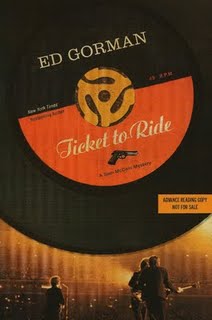 I’ve read quite a few books by Ed Gorman, but somehow the Sam McCain series got by me. So naturally I’m starting with the newest entry, which is also possibly the last. Still, better late than never.
I’ve read quite a few books by Ed Gorman, but somehow the Sam McCain series got by me. So naturally I’m starting with the newest entry, which is also possibly the last. Still, better late than never.
Sam is a lawyer/investigator in Black River Falls, Iowa. It’s 1965. The local minister is burning Beatles records and people are starting to pay attention to the conflict in Vietnam. Some, like Sam, are doing more. They’re organizing protests, incurring the wrath of more conservative friends and neighbors. Shortly after one such rally goes awry, there’s a murder. As far as the sheriff is concerned it’s tied to the demonstration, but Sam unearths connections to a death that rocked the town several years before.
It’s a Gorman novel, so you get a well-turned plot, deft pop culture references, and sharp observations on small town life. You also get characters who don’t conform to expectations. The golden boy activist railroaded into jail? He’s something of an operator. The die-hard patriot ready to tar and feather is also a grieving father. Then there’s Sam himself, aware of all these incongruities as he struggles to do the right thing.
Here’s Ed in conversation with Tom Piccirilli about Ticket to Ride, the earlier Sam McCain books, and other sundry matters.
Saturday, December 05, 2009
Book: Losers Live Longer, by Russell Atwood (2009)
Exhibit A: The rare horizontal cover.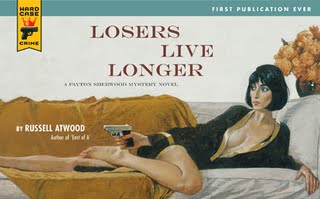 Like I’m not gonna read that.
Like I’m not gonna read that.
Exhibit B is the setting in Manhattan’s East Village, specifically a few blocks where I’ve spent my share of time. But what cinched it for me was this review by James Reasoner. When he called this Hard Case Crime book “one of the best private eye novels of recent years,” I stopped in at Seattle Mystery Bookshop and picked it up that day.
Payton Sherwood is the P.I. in question. Down-at-heel (for a few chapters literally), he’s happy to be asked by a legendary retired operative to pitch in for a few hours on a case. When the senior shamus turns up dead on his doorstep, Payton decides to follow through on the job – even though he has no idea what it is. Before his long day is through, he’ll tangle with porn kingpins, indie filmmakers, and, of course, beautiful women. It’s old school pulp served up with a sharp contemporary sensibility. Fast, ferocious and authentically funny. Don’t miss it.
DVD: Edgar G. Ulmer: The Man Offscreen
Cult director Ulmer was the king of Poverty Row, a man who could stretch a budget to the breaking point and, with 1945’s Detour, created true dark magic. This 2004 documentary reveals that the man who made something out of nothing in his work did the same with his own life story. Stylishly shot, featuring comments from collaborators (Ann Savage, William Schallert) and admirers (Wim Wenders, Joe Dante, John Landis). The best stuff comes late as John Saxon and Peter Marshall, costars of Ulmer’s last film The Cavern, bicker in the back of a convertible before a rear-projection screen.
As an extra you get an entire Ulmer movie, 1943’s Isle of Forgotten Sins. It’s the South Seas by way of North Hollywood, the ocean-going scenes shot with models and the deep sea diving done by marionettes. Not good by any stretch, but strangely compelling and, as always with Ulmer, done with ingenuity.
Tuesday, December 01, 2009
Movies: A Phil Karlson Thanksgiving
The Phil Karlson Thanksgiving Weekend wasn’t planned. It was an act of necessity.
The problem is I’d become obsessed with that clip of John Payne and others performing “The Girlfriend of the Whirling Dervish” in Garden of the Moon. (Have you watched it yet? Go ahead. I’ll wait.) After repeated viewings of an impossibly young John Payne deftly tossing off Johnny Mercer’s lyrics, I needed to restore to my memory the older version. His face collapsed yet even more magnetic. In trouble and sinking deeper. The noir John Payne. That actor’s best collaborator was ex-prop man turned director Karlson. Time to revisit their finest hour.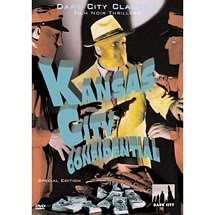 In Kansas City Confidential (1952), Payne plays an ex-con whose efforts to go straight mean nothing when he becomes the unintentional fall guy in a daring robbery. The simmering fury when he’s sprung from jail knowing that no one legit will ever trust him again is scorching. That bone-deep sense of betrayal, of hard work going for naught, charges the rest of the film, which despite the title is set mostly south of the border. Karlson as always keeps the action taut, and there’s the added bonus of what has to be the most badass crew in the annals of noir: Jack Elam, Lee Van Cleef, and Neville Brand.
In Kansas City Confidential (1952), Payne plays an ex-con whose efforts to go straight mean nothing when he becomes the unintentional fall guy in a daring robbery. The simmering fury when he’s sprung from jail knowing that no one legit will ever trust him again is scorching. That bone-deep sense of betrayal, of hard work going for naught, charges the rest of the film, which despite the title is set mostly south of the border. Karlson as always keeps the action taut, and there’s the added bonus of what has to be the most badass crew in the annals of noir: Jack Elam, Lee Van Cleef, and Neville Brand.
Appetite whetted, I craved more. And had it on hand, thanks to the new Columbia Pictures Film Noir Classics Collection. I’d wanted to see 5 Against the House (1955) for years, and not just for Karlson. It’s based on a Jack Finney story, adapted by Stirling Silliphant (In the Heat of the Night) and William Bowers (Cry Danger, The Mob). Imagine my surprise to discover it’s the rare Karlson film that’s a total misfire.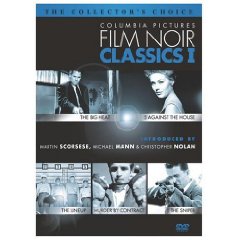 5ATH begins as a tiresome college comedy then becomes a heavy-handed survey of the problems faced by returning Korean War vets taking advantage of the G.I. Bill before settling into a heist groove. The “perfect plan” posited by these aging students would be ridiculous under any circumstances, but on the heels of the ingenious scheme cooked up in Kansas City Confidential it’s downright embarrassing. There’s nice work by Brian Keith as the most damaged vet and a good climax set in an automated parking garage in Reno, but little else.
5ATH begins as a tiresome college comedy then becomes a heavy-handed survey of the problems faced by returning Korean War vets taking advantage of the G.I. Bill before settling into a heist groove. The “perfect plan” posited by these aging students would be ridiculous under any circumstances, but on the heels of the ingenious scheme cooked up in Kansas City Confidential it’s downright embarrassing. There’s nice work by Brian Keith as the most damaged vet and a good climax set in an automated parking garage in Reno, but little else.
ASIDE: Also in the Columbia collection is a superior Silliphant-scripted drama, 1958’s The Lineup (reviewed here), that features one of the greatest recent commentary tracks. My friend Eddie Muller and novelist James Ellroy tag-team on this one, Eddie providing a native San Franciscan’s view while Ellroy gives full vent to his obsessions. Eddie gave me a heads up after they recorded the track, saying, “It’s a wild one.” It lives up to that billing.
In the immortal words of Homer Simpson, you can’t go this far and not go further. On to the Karlson films parked on the DVR.
I’d seen 1955’s The Phenix City Story, but never with the reportorial prologue including interviews with several of the people involved in this true story. This segment made it easier to get scenes of still-shocking violence past the censors. Without it the movie opens with a haggard roadhouse number, ‘The Phenix City Blues,’ that swiftly presents the low-rent reality of life in an Alabama town choking on the vice aimed at soldiers in neighboring Fort Benning. Karlson and Georges Simenon make a natural match in The Brothers Rico (1957), with Richard Conte as an erstwhile Mafia accountant who thinks he’s made a clean break to become a cleaner, only to find himself doing the Organization’s bidding when his siblings go astray. With a dandy performance by Harry Bellaver as a local kingpin who orders hits and dinner in the same breath. They’re both tough-minded movies with a view of mobsters similar to the one articulated in Josh Bazell’s novel Beat the Reaper:
Proudly ignorant, personally repellent, absolutely convinced that their willingness to hire someone to beat money out of someone who worked for a living constitutes some kind of genius and an adherence to a proud tradition.
99 River Street, a John Payne/Phil Karlson film that screened at Noir City 2007, is currently available on Hulu and Fancast. You could be watching it right now! Here’s Ivan’s take at Thrilling Days of Yesteryear. I look at Karlson’s final film Framed here.
Saturday, November 28, 2009
Book: Pariah, by Dave Zeltserman (2009)
There’s dark, and then there’s dark.
Pariah, the latest from Dave Zeltserman – the sick puppy of crime fiction, says the Washington Post (sort of) – opens with Kyle Nevin’s release from prison. The South Boston gangster did his full bid, which is more than can be said for his boss, an FBI rat now in the wind. Kyle plans on tracking him down once he pulls off a kidnapping to give him operating capital.
Things don’t go well.
You know Zeltserman is up to no good with the page one note from Kyle to his editor. More are scattered through the text. How Kyle ended up writing the manuscript you’re reading is too twisted and too bleakly funny to spoil here.
It’s been a while since I’ve read a book that genuinely disturbed me, but Pariah takes that crown. Kyle Nevin is a stone-cold predatory sociopath who never dresses up his ruthlessness. I loathed the guy. I also couldn’t stop reading about him. At least Joe Denton, the protagonist of last year’s Zeltserman scorcher Small Crimes, tried to justify his self-serving actions. Kyle can’t be bothered, which makes him either terrifyingly compelling or compellingly terrifying. After all, rationalization is what separates us from the animals. Except for dolphins. Those flippered punks rationalize constantly. And what does it get them?
Wednesday, November 25, 2009
TV: Edge of Darkness (1985)
For years I’ve said that Edge of Darkness was the greatest program I’d ever seen on TV. And Stateside at least, nobody knew what the hell I was talking about.
I was a high school kid when this six-part miniseries aired in the U.S. Unlike most BBC productions it didn’t run on PBS but in syndication, which may account for what I remember as a lack of fanfare. I watched it over three consecutive nights, and it left quite an impression. The score by Eric Clapton and Michael Kamen still drifts through my head, and several images from the closing episode are seared in my memory. I even remember the character names, for crying out loud, and sometimes utter one of them – Darius Jedburgh – to relish its sheer awesomeness.
Ronald Craven is a widowed Yorkshire detective, principled but pliable. He’s in the midst of investigating union corruption when a gunman ambushes him at his home. Craven’s student activist daughter Emma is killed. The theory is that an old adversary is seeking revenge, but Craven begins to suspect that his daughter was the actual target.
The script by Troy Kennedy Martin (Z Cars, The Italian Job, Reilly, Ace of Spies) had the foresight to look past the Cold War and say screw the Russians, we’ve got bigger problems. Corporate malfeasance, environmental radicalism, mistrust among allies and intelligence agencies. It seemed to know exactly what was coming after the glasnost era.
Earlier this month, Edge of Darkness finally became available on DVD. Revisiting it for the first time in over twenty years, I continue to be impressed.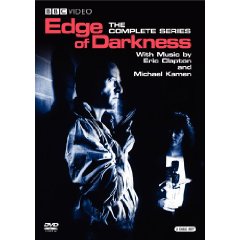 Sure, it’s dated somewhat. In 1985, after all, you had to break into a building to gain access to a computer network. It’s deliberately paced, there are a few story issues, and the politics in the wrap-up can get a touch ... allegorical. But it remains a staggeringly prescient work; it amazes me that Martin addressed these issues directly in the 1980s. And the program’s emotional power hasn’t dimmed a bit, thanks to some dazzling acting.
Sure, it’s dated somewhat. In 1985, after all, you had to break into a building to gain access to a computer network. It’s deliberately paced, there are a few story issues, and the politics in the wrap-up can get a touch ... allegorical. But it remains a staggeringly prescient work; it amazes me that Martin addressed these issues directly in the 1980s. And the program’s emotional power hasn’t dimmed a bit, thanks to some dazzling acting.
Joe Don Baker is a revelation as the wily CIA officer Jedburgh, giving the role his all. What’s astonishing is that as powerful as Baker is, it’s still not the best performance in the series.
Bob Peck’s Craven is a man of guarded emotions and inappropriate intimacies – with his daughter, with men he’s interrogating. He’s both genuinely good yet strangely unreadable. Peck died of cancer far too young at age 53, leaving behind a brief but indelible filmography. There’s his turn as the great white hunter in Jurassic Park, uttering “Clever girl” with a note of admiration before he’s slain by the raptor he’s stalking. And there’s Craven in Edge of Darkness, which goes on my list of the best performances I’ve ever seen.
Time for some blasphemy. Edge of Darkness has been remade as a feature film due early next year, and I think it’s a good idea. The story is as relevant as it ever was. Martin’s script has been updated to the U.S. by Oscar winner William Monahan (The Departed) and Andrew Bovell (the lamentably under-seen Lantana). The roles originated by Peck and Baker are now played by Mel Gibson and Ray Winstone. And Martin Campbell, who directed the original series before rebooting the James Bond franchise not once (GoldenEye) but twice (Casino Royale), is back behind the camera.
However the movie turns out, it simply won’t have the room afforded by the mini-series format to flesh out its characters. I don’t know that I’d still call Edge of Darkness the greatest program I’ve ever seen on TV, but it is in the running. It’s certainly the finest thriller ever produced for the small screen.
Monday, November 23, 2009
Movies: The Quality of Mercer
Amidst multiple deadlines I’ve been making my way through some of the films in Turner Classic Movies’ month-long salute to the centenary of the birth of Johnny Mercer, singer and songwriter extraordinaire.
1937’s Ready, Willing and Able introduced “Too Marvelous for Words,” as well as some lesser tunes. (“Handy With Your Feet,” anyone?) “Marvelous” is featured several times, most memorably in the stupendous closing number. When it was excerpted in TCM’s Mercer documentary, Rosemarie began waving her hands in front of her face like a giddy six year old. Ruby Keeler and Lee Dixon, a second-rate Cagney impersonator trapped in Conan O’Brien’s body, dance on a gigantic typewriter with the legs of a bevy of chorines serving as typebars. Based on the words that appear on the equally enormous sheet of paper behind them, it’s a non-QWERTY keyboard.
I just looked down to spell QWERTY. How sad is that?
Hollywood Hotel (1937) gave the world “Hooray for Hollywood,” the tongue-in-cheek anthem that Tinseltown took at face value, belted out by Johnnie ‘Scat’ Davis. The real reason to watch is the Benny Goodman Orchestra performing “Sing, Sing, Sing,” followed by a tight session with Benny, Gene Krupa and Lionel Hampton.
Garden of the Moon (1938) is the least regarded of the three films that we saw, so naturally I liked it the most. Lots of novelty songs here performed by a band that includes Davis, John Payne and Jerry Colonna, among them “The Lady on the Two-Cent Stamp.” The closest thing to a standard on the soundtrack is “The Girlfriend of the Whirling Dervish,” and when I heard it I got a touch giddy myself. Whenever Warner Brothers needed a hint of Arabian Nights mystery in a cartoon, they’d play an instrumental version of this song. Which is unfortunate, because the lyrics show off Mercer’s wordplay at its best.
She’s got her nervish
Throwing him a curvish
Which, of course, he doesn’t deservish
Astute readers will have noticed I haven’t bothered with plot synopses. All three movies are trifles, showbiz farces with mistaken or bogus identities. There’s just enough story to keep things humming ‘til the next tune starts. Warner Brothers’ musicals owe something to the studio’s signature crime dramas; they’re earthy and sharp, with a kick of bourbon in the meringue. It’s worth noting that these three films, in addition to the handiwork of Johnny Mercer, also share writing by Jerry Wald and Richard Macaulay. They would later pen They Drive by Night and Manpower together, while as a producer Wald would make Mildred Pierce, Dark Passage and one of my favorite backstage dramas, The Hard Way.
TCM has one more night of Johnny Mercer fare airing on Wednesday – after their showing of The Money Trap at 4:15PM EST, 1:15PM PST. I told you there’d be other reminders.
UPDATE: Here’s “The Girlfriend of the Whirling Dervish,” which grows progressively unhinged. It’s still odd to see John Payne singing, considering that I think of him as the lead in noirs like Kansas City Confidential and Slightly Scarlet. Oddly the original choice to star in Garden of the Moon was Dick Powell, who preceded Payne down the boy-singer-to-tough-guy path.
Wednesday, November 18, 2009
Extra, Extra!: Noir City Sentinel
Hear that sound, kids? It’s issue #28 of the Noir City Sentinel, trade rag of the Film Noir Foundation, hitting in-boxes around the globe. Why not cough up a few shekels and get yourself a copy?
Eddie Muller, Don Malcolm and company have truly outdone themselves this go-round. The issue focuses on the role that the blacklist played in film noir. Included for your entertainment and enlightenment:
* Several perspectives on enigmatic expat Joseph Losey
* Alan K. Rode on the extraordinary career of writer, producer, Oscar winner and con man Philip Yordan
* A blacklist case study from Jake Hinkson on He Ran All the Way
* An astonishing piece by film writer Ehsan Khoshbakht surveying noir in Iran
All that plus a report on the first Noir City: Lyon, Elvis noir, and more, not to mention a tribute to the cinematic union of Glenn Ford and Rita Hayworth penned by yr. humble correspondent. Please note that my contribution leans heavily on a terrific, little seen 1966 film called The Money Trap. It’s finally available on DVD from the Warner Archive, but it will also be getting a rare television airing courtesy of Turner Classic Movies on Wednesday, November 25 at 4:15PM EST, 1:15 PM PST. Schedule your travel plans and turkey consumption accordingly. This will be the first of several reminders.
In the meantime, contribute to the Film Noir Foundation and get a Sentinel all your own. You won’t be disappointed.
Sunday, November 15, 2009
DVD: The Merry Gentleman (2009)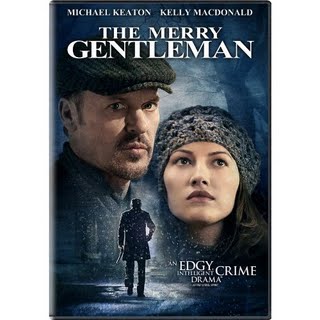 This movie opened at my neighborhood theater earlier this year on a Friday when I was heading out of town. I made a note to see it on my return but never had the chance; by Wednesday it was gone. It deserved better than a five-day run. A lot better.
This movie opened at my neighborhood theater earlier this year on a Friday when I was heading out of town. I made a note to see it on my return but never had the chance; by Wednesday it was gone. It deserved better than a five-day run. A lot better.
Chez K favorite Michael Keaton plays a suicidal assassin. Through a random act of kindness he crosses paths with Kelly Macdonald, a women fleeing an abusive relationship. A strange bond forms between the two over a blustery Chicago winter.
Keaton, typically a bundle of energy, opts for a powerful stillness here, achieving all he needs with a flicker of his facial muscles. He’s also sporting a great look. Macdonald beguiles in a role that requires every man to fall in love with her. Using her own Scottish accent aids in that enormously. Tom Bastounes shines as a lonely detective smitten with Macdonald, and the always welcome Bobby Cannavale is a powerhouse in his scene as Macdonald’s husband, never quite apologizing for his actions while touting his newfound salvation.
Most impressive of all is Keaton’s direction of the film. (The actor took over behind the camera when screenwriter Ron Lazzeretti suffered appendicitis.) The Merry Gentleman is a quiet, deliberate movie, and Keaton nails the tricky tone from the outset. He has a nice eye for composition and an unforced feel for working people; the interactions with cops and hospital staff have the texture of real life. Pair this sleeper with Blast of Silence for a Christmas hit man double-bill.
Wednesday, November 11, 2009
Book: The Financial Lives of the Poets, by Jess Walter (2009)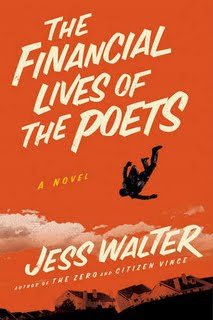 Matthew Prior is in trouble. He’s been downsized from his newspaper job after the failure of his own business venture, a website offering financial advice in verse. A massive balloon payment is due on his house in a matter of days. He hasn’t told his wife about it because she’s busy preparing for an affair with her old boyfriend. Then Matt hits on a way to retain his redoubt in middle-middle class heaven. He’s going to sell primo pot to his fellow boomers. He’s even got a street name. Slippers.
Matthew Prior is in trouble. He’s been downsized from his newspaper job after the failure of his own business venture, a website offering financial advice in verse. A massive balloon payment is due on his house in a matter of days. He hasn’t told his wife about it because she’s busy preparing for an affair with her old boyfriend. Then Matt hits on a way to retain his redoubt in middle-middle class heaven. He’s going to sell primo pot to his fellow boomers. He’s even got a street name. Slippers.
Jess Walter covers a lot of ground in this novel: the immediate effects of the economic meltdown, the slow death of old media, the perils of social networking. So determined is he to pin down every aspect of life-at-this-instant that the overstuffed plot verges on antic. But each page brings a turn of phrase or an observation about contemporary America that is electrifying, laugh-out-loud funny, or both. And there are poems.
Walter, an Edgar Award winner, National Book Award nominee and author of the best crime novel you’ve never read, has a sharp yet forgiving eye. Matt notes, “Perhaps the most pathetic thing about long-married guys like me is the delusional list that each of us keeps in our heads, a list of women we think are secretly attracted to us.” He then introduces us to one of the names on his personal roster, an HR gatekeeper whose inappropriate suits are described as “0-2 fastballs – little high, little tight.”
Over the course of the book, Matt learns that there are no such things as epiphanies. But damned if he doesn’t keep having them even in the midst of the most mundane activities, like ordering dinner for his sons.
So I make one phone call, and just like that, we’re eating pizza at 6:30. What is this world? You tap seven abstract figures onto a piece of plastic thin as a billfold, hold that plastic device to your head, use your lungs and vocal chords to indicate more abstractions, and in thirty minutes, a guy pulls up in a 2,000-pound machine made on an island on the other side of the world, fueled by viscous liquid made from the rotting corpses of the dead organisms pulled from the desert on yet another side of the world and you give this man a few sheets of green paper representing the abstract wealth of your home nation, and he gives you a perfectly reasonable facsimile of one of the staples of the diet of a people from yet another faraway nation.
And the mushrooms are fresh.
Friday, November 06, 2009
Book: Hummingbirds, by Joshua Gaylord (2009)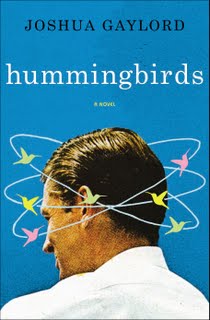 It was always odd to encounter one of my teachers outside the confines of the classroom. I’d be at the mall on Saturday afternoon and run into Mr. Granding, 6th period history. The ensuing conversation would be awkward and brief. For those few moments, he’d no longer be an imposing, vaguely unknowable figure who only had to flip to the back of the book for the answers. He’d become a suburban father, one of legion, pushing a stroller, wearing an ill-fitting sports shirt and ... dude, are those sandals?!?
It was always odd to encounter one of my teachers outside the confines of the classroom. I’d be at the mall on Saturday afternoon and run into Mr. Granding, 6th period history. The ensuing conversation would be awkward and brief. For those few moments, he’d no longer be an imposing, vaguely unknowable figure who only had to flip to the back of the book for the answers. He’d become a suburban father, one of legion, pushing a stroller, wearing an ill-fitting sports shirt and ... dude, are those sandals?!?
That academic overlap of worlds public and private, adult and adolescent is the subject of Hummingbirds, the lovely debut novel by Joshua Gaylord. A new year starts at the Carmine-Casey School for Girls on Manhattan’s Upper East Side. Two seniors, one popular and one smart, warily circle each other for the last time. Meanwhile Leo Binhammer, for years the only male teacher in the English department, has to make room for an interloper with whom he will develop a complex friendship. Gaylord flits between characters with an almost-but-not-quite omniscient voice that he deploys to startling effect. The result is a novel that, like the girls at its center, is delicate yet surprisingly resilient.
I had the chance to hear Josh read from Hummingbirds last month in New York, as well as meet his wife, Edgar Award winner Megan Abbott. A literary power couple who have written two of my favorite books this year. I’m entitled to hate them a little bit for this.
TV: What I’ve Been Watching
While not tuned to a World Series in which I was rooting for inclement weather, that is.
Poliwood. Barry Levinson’s loosely-structured “film essay” about showbiz and politics covers no new ground but does include some fascinating scenes. One shows ex-GOP pollster turned consultant Frank Luntz leading a communication seminar for members of the Creative Coalition at the 2008 Democratic National Convention. He tells the assembled actors that he admires their passion, but that if they change their language they can reach a wider audience. Several actors immediately take offense and turn it into a First Amendment issue, thus proving his point. Later, Levinson and Luntz arrange a focus group on celebrity at the RNC. One woman tears into the actors with an almost sensual relish. That the person she describes – having millions of dollars, multiple homes and no commonality with regular Americans – sounds more like John McCain than Tim Daly passes without comment.
Johnny Mercer: The Dream’s On Me. I’m a Mercer fan and this documentary had me saying, “He wrote that song, too?” Factor in his singing, his role in founding Capitol Records and his work as a producer, and it’s clear that Mercer is one of the great men of the twentieth century. For the record, the other names on that list are Winston Churchill, Alfred Hitchcock, and Tom Seaver.
Sunday, November 01, 2009
Book: The Ghosts of Belfast, by Stuart Neville (2009)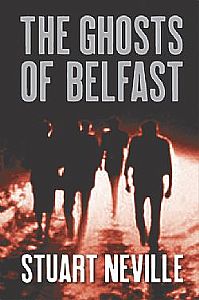 During the mystery vs. thriller panel at Seattle Bookfest, author Robert Ferrigno said he preferred thrillers because they allowed more room to explore character. (For the record, I still think there should have been someone arguing the mystery side of this panel in the interests of fairness.) (Also for the record, I bring up Bookfest again because being cited in The Stranger’s coverage is the closest I’ve come to being enmeshed in a literary feud, and I’m enjoying that.) ( ... ) (What the hell was I talking about? Oh, right.) You’d be hard-pressed to find better proof of Ferrigno’s argument that the debut novel by Stuart Neville, published in the U.K. and elsewhere as The Twelve.
During the mystery vs. thriller panel at Seattle Bookfest, author Robert Ferrigno said he preferred thrillers because they allowed more room to explore character. (For the record, I still think there should have been someone arguing the mystery side of this panel in the interests of fairness.) (Also for the record, I bring up Bookfest again because being cited in The Stranger’s coverage is the closest I’ve come to being enmeshed in a literary feud, and I’m enjoying that.) ( ... ) (What the hell was I talking about? Oh, right.) You’d be hard-pressed to find better proof of Ferrigno’s argument that the debut novel by Stuart Neville, published in the U.K. and elsewhere as The Twelve.
For years Gerry Fegan was one of the most feared killers at the IRA’s disposal. Now the men who ordered him to commit murder are politicians and power brokers while he downs whiskey to still the voices in his head. Only they’re not just voices. Fegan’s victims appear to him in physical form, dogging his waking hours and denying him sleep. But at long last, these damned souls are telling Fegan how to end his torment. All he must do is eliminate those who are responsible for their deaths.
Neville lays out the complexities of Northern Ireland politics without ever letting the pace flag. And he fills the pages with a rich array of characters, including undercover agents and dealmakers. None are more fascinating than Fegan. He becomes even more compelling with the early revelation that he saw “shades” as a child, a risky move that lends an element of the supernatural to an already potent thriller.
Movie: The Damned United (2009)
Here’s how much of a Peter Morgan/Michael Sheen fanboy I am. The fourth collaboration between this writer and actor, based on a novel by David Peace, got me to give a damn about soccer. (Fine, overseas readers, football. Happy now?) This after I’ve proven immune to Seattle Sounders mania, which has swept through this town like swine flu.
There’s not a lot of action on the pitch in the movie, the story of charismatic coach Brian Clough’s disastrous six-week reign at the helm of Leeds United in 1974. But there’s drama to spare. Two thoughts:
Never have I seen an actor who more resembles the real-life figure he’s playing than Colm Meaney and Clough’s predecessor, Don Revie.
I’ll say this for ... football. Failure has consequences. Lose badly enough and you’re demoted an entire division. Last year a certain Pacific Northwest team that will remain nameless became charter members of baseball’s 100/100 club, the first franchise to lose 100 regular season games with a payroll in excess of 100 million dollars. Come 2009, they still got to play the Yankees. A little fear might not be such a bad thing.
Friday, October 30, 2009
Miscellaneous: The Most Terrifying 3:34 on YouTube
Martin Scorsese names the eleven scariest movies of all time. Five horror novelists including Joe R. Lansdale weigh in with their choices.
With all due respect, these people are rank amateurs.
In honor of Halloween, I am again offering a combination of sound and image that will chill the blood and drive good men mad. It’s the closing three minutes and thirty-four seconds from Paul Lynde’s 1976 Halloween special.
Watch the whole show if you dare, ideally through one of these. I accept no responsibility for what happens to you.
Thursday, October 29, 2009
Book: How I Became a Famous Novelist, by Steve Hely (2009)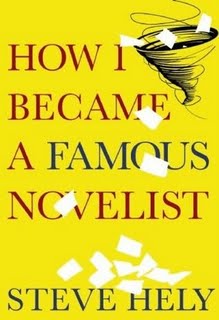 You have no idea how bizarre it was to attend a literary festival after reading this book.
You have no idea how bizarre it was to attend a literary festival after reading this book.
Pete Tarslaw receives an invitation to his former girlfriend’s wedding and reacts the way many of us would: he vows to become, well, a famous novelist. That way on the big day he can outclass the other guests and make his ex rue her decision. Pete’s not out to write a good book, just a popular one. Armed with a list of what such an opus must contain – lyrical prose, lots of food references, some kind of club and at least one murder – he sets out to conquer the bestseller list.
Hely, a former Letterman staffer now on 30 Rock, pulls off a singular trick. He manages to send up everything related to publishing. Nothing is spared. Amazon, writing workshops, MFA programs, editors desperate to get into the film business, self-serious book blogs. He serves up a note-perfect parody of Entertainment Weekly’s simultaneously knowing and vacuous house style. The excerpts from other books are particularly vicious; he includes a few paragraphs from a crime novel that aren’t far removed from ones I’ve seen in print. By the halfway point, he was getting me to laugh on the basis of titles alone. (The Widows’ Breakfast? Come on!) Unlike many satirical novels it holds up to the end, which also packs an emotional kick.
But as funny as the book is – and it is, howlingly so – it’s also chilling. With his clinical determination to anatomize popular fiction and create a Frankenstein’s monster version of his own solely to one-up his girlfriend, Pete Tarslaw is a soulless beast straight out of noir. It’s as if a Patricia Highsmith protagonist took up a pen, or one of Jason Starr’s characters turned reporter. (Jason Starr, Reporter. Get it? Yeah, I knew it was a reach.) That dark drive only makes Pete’s story more hilarious. I can’t recommend this one enough.
Monday, October 26, 2009
Report: Seattle Bookfest Seattle loves to read. Every year it takes a position near the top of the list of America’s most literate cities. Name me another major burg that turned its chief librarian into an action figure.
Seattle loves to read. Every year it takes a position near the top of the list of America’s most literate cities. Name me another major burg that turned its chief librarian into an action figure.
But for some reason – ornery regional independence, I suppose – it has trouble sustaining an annual book festival. Northwest Bookfest went belly-up in 2003. Some enterprising locals rebooted it as Seattle Bookfest. The new version is more low-key, focusing on local authors and independent booksellers. It was held in Columbia City, one of Seattle’s funkier neighborhoods. (Most sections of town aspire to be San Francisco. Columbia City aims to be Portland.)
I wanted to support Bookfest 2.0. Recent Bouchercon coverage by Christa Faust and Donna Moore had me jonesing for some literary action of my own. And Columbia City is also a stop on Seattle’s new light rail line. The Bookfest provided the perfect excuse for my inaugural trip on Saturday afternoon. I’m a destination-not-the-journey kind of guy.
The venue was a former school, with the best panels held in a portable classroom. I swore when I graduated that I would never set foot in such structures again, so thanks for making a liar out of me, Bookfest! We missed some of the panel on graphic novels moderated by Fantagraphics co-founder Gary Groth, but what we did catch was interesting. What I remember:
- The use of space is essentially a writing tool in comics.
- Every comic should be read twice, once for the story and once for the composition.
- If you doubt that we have become a culture that processes information visually, just look at your interaction with your phone.
Next came the crime fiction panel. The session’s title – The Difference Between Mystery & Thriller – seemed a bit obvious, which raised concerns. As did the I’m-gonna-say indifferent moderating. I’m not going to embarrass the woman by name because she never bothered to provide hers. She sat down, asked the authors to introduce themselves, then turned to the audience and said, “OK. Any questions?” Fortunately the panelists – Robert Ferrigno, Michael Gruber and Kevin O’Brien – were pros and sustained a lively if general discussion about thrillers.
We wrapped things up with a reading by National Book Award winner Pete Dexter. Only it wasn’t a reading, more of an alphabetical presentation of his semi-autobiographical novel Spooner. Dexter went from A to Z, offering glimpses of what’s in the book. (“A is for anthill.”) Sometimes he’d read a paragraph or two to illustrate, sometimes he’d describe the material off the cuff, sometimes he’d veer into digressions about current events or words he had trouble pronouncing. The approach worked. Whenever Dexter did quote from Spooner the crowd wanted more, and I’ll be reading the book post haste.
Bumps and glitches aside, it was a promising start for the new iteration of Bookfest. As for light rail: smooth ride, frequent trains, decent fares. I’ll give that another shot, too.
UPDATE: The Stranger’s postmortem of the event is far more dire - and cites this very post in a vaguely disparaging way, which I consider a moral victory. For the record, their assessment jibes with what I saw.
Friday, October 23, 2009
DVD: Anvil! The Story of Anvil (2009)
It’s not just one of the best titles of the year. This documentary is also one of the best movies.
The Canadian band Anvil is a pioneer in heavy metal music. Guys from Anthrax, Guns N’ Roses and Motörhead attest to their unassailable awesomeness. The movie opens with rare footage from an epic 1984 Japanese metal fest featuring Anvil’s lead singer Lips wearing a bondage harness and playing the ax with what ‘70s game shows used to call a marital aid.
Many of the acts on that bill went on to achieve success. Not Anvil. A series of bad breaks kept them in the minor leagues, famous only to other musicians and a small circle of fans. But the band keeps rocking. Sacha Gervasi, a screenwriter who was an Anvil roadie in their brief ‘80s heyday, picks up their story as they set aside their day jobs to embark on an extended European tour organized by their guitarist’s girlfriend and then record their thirteenth album.
It’s a real-life Spinal Tap crossed with The Wrestler, following men in their fifties who won’t give up on their dream even in the face of age and common sense. It’s about family, friendship, and the power of belonging to a community. I may have teared up once or twice, but I was banging my head so nobody noticed.
Monday, October 19, 2009
Book: Blood’s a Rover, by James Ellroy (2009)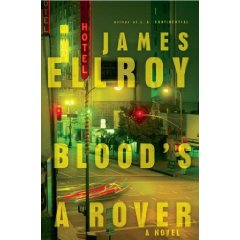 The years: 1968-72. The men: factotums and hoods beset by personal demons and on the precipice of history. J. Edgar Hoover’s pet thug. An ex-cop/chemist with daddy issues aiding and abetting Howard Hughes’ takeover of Las Vegas. A wannabe private eye. This being Ellroy’s scarred funhouse mirror version of reality, at least one of them will wind up dead, and any survivors will be disillusioned and damned.
The years: 1968-72. The men: factotums and hoods beset by personal demons and on the precipice of history. J. Edgar Hoover’s pet thug. An ex-cop/chemist with daddy issues aiding and abetting Howard Hughes’ takeover of Las Vegas. A wannabe private eye. This being Ellroy’s scarred funhouse mirror version of reality, at least one of them will wind up dead, and any survivors will be disillusioned and damned.
American Tabloid, which kicked off Ellroy’s Underworld U.S.A. trilogy, remains one of my favorite books. The Cold Six Thousand, which followed, left me colder than the title sum. That’s partly the nature of the epic story Ellroy chose to tell. David Mamet once explained the three-act structure by citing a possibly apocryphal headline: Boy Cuts Off Father’s Head, Cuts Off Parakeet’s Head, Then Cuts Off Lizard’s Head. The key, Mamet said, is to have the kid cut off his father’s head last. Tabloid had the JFK hit as its dark, beating heart. C6K has to grapple with the chaotic ensuing years, and it’s tough to depict a time when the center did not hold. Ellroy’s obsessions, immodest enough as to not go even thinly veiled, and his baroque molecular plotting didn’t help.
I feared for the long-gestating Rover because the period it covers lacks the outsized events that provided a structure for its predecessors. But the dearth of obvious set pieces spurs Ellroy’s ingenuity. The lynchpins here are an armored car heist in early ‘60s L.A., the Mafia’s attempt to reboot its Caribbean glory in the Dominican Republic, and a left-wing Lorelei known as the Red Goddess Joan. She’s a cipher until the closing section, but when she does finally come into focus she’s quite formidable.
I liked Rover. It’s no Tabloid, but its “rogue authoritarians” make it a mighty improvement on C6K. Perhaps the books will read differently if consumed all at once, as a single epic narrative. Feature it: the panty-sniffer’s Lord of the Rings.
Book: You’re Nobody ‘Til Somebody Kills You, by Robert J. Randisi (2009)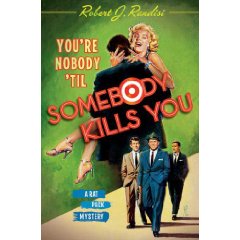 What are the odds that I would read two novels in a row featuring Hollywood P.I. Fred Otash as a character? Considering my interests, they’re actually pretty good.
What are the odds that I would read two novels in a row featuring Hollywood P.I. Fred Otash as a character? Considering my interests, they’re actually pretty good.
Shamus-to-the-stars Otash is a minor figure in Rover but lands a decent supporting role in Randisi’s fourth Rat Pack mystery. Sands pit boss Eddie Gianelli is again asked for a favor by famous pals Frank and Dean. This time it’s to help a peripheral member of the Clan, Marilyn Monroe, who’s convinced that she’s being followed. We also learn more about Eddie G as he heads home to Brooklyn to deal with his estranged family. Randisi’s take on Marilyn, the sex bomb who becomes everybody’s kid sister, seems spot on. The book is the kind of breezy concoction you’d expect from an author who recently took home a lifetime achievement award from the Private Eye Writers of America.
Here’s a little of Freddy Otash in action, in a Tinseltown dustup involving Peruvian songbird Yma Sumac. Who was not, as urban legend claims, a Brooklyn girl named Amy Camus.
Tuesday, October 13, 2009
Meme: Reading Habits
It’s been a while since I tackled a meme. I spotted this one at James Reasoner’s Rough Edges and at The Rap Sheet.
Do you snack while you read? If so, what is your favorite reading snack?
No. Of course, I do make exceptions. See below.*
Do you tend to mark your books as you read, or does the idea of writing in books horrify you?
I have been known to erase marks in library books, so this one’s also a no.
How do you keep your place while reading a book? Bookmark? Dog-ears?
I haven’t made dog-ears in dog’s years. (I cop to doing so as a kid, but I didn’t know any better then.) I’m a bookmark man. I have a stack of them, but keep abusing the same two.
Laying the book flat open?
Sure, if the book’s big enough. And if it’s into that.
Fiction, nonfiction, or both?
I’d guess a 70/30 ratio of fiction to non-fiction. The former is mostly crime fiction or thrillers, the latter a mix of research reading and whatever piques my interest.
Hard copy or audiobooks?
I have listened to exactly one (1) audiobook. My commute’s not long enough. A more interesting question would be: hard copy or e-books? I still don’t own a Kindle, but I’m thinking about it.
Are you a person who tends to read to the end of a chapter, or can you stop anywhere?
I can stop anywhere, but typically I’ll read to the end of a chapter. I color inside the lines as well. What can I say? I went to Catholic school.
If you come across an unfamiliar word, do you stop and look it up right away?
If it doesn’t make sense in context, yes.
What are you currently reading?
Coming down the homestretch on Blood’s A Rover by James Ellroy. The last non-fiction book I read, after years of prompting by my brother – hi, Sean! – was Michael Lewis’ Moneyball.
What is the last book you bought?
During my recent New York trip I picked up Tower by Reed Farrel Coleman and Ken Bruen, signed by Reed at the Mysterious Bookshop launch party. I also scored a haul at the Strand including Build My Gallows High by Geoffrey Homes, later filmed as Out of the Past, and Leo C. Rosten’s Hollywood, a study of the movie business in the 1930s published in 1941.
Are you the type of person that reads one book at a time, or can you read more than one?
Again, I can but I don’t. I’ll read a non-fiction research book at the same time as a novel, but I prefer not to.
Do you have a favorite time/place to read?
Every night, I lie on my living room sofa and read for at least half an hour. Reading in a coffee shop, which I did for a while this afternoon, is one of life’s great luxuries. Other settings can be quite nice, too. See below.*
Do you prefer series books or stand-alones?
Stand-alones.
Is there a specific book or author you find yourself recommending over and over?
Lawrence Block. Donald E. Westlake. Richard Price. All these years on the West Coast, and I’m still a New York boy at heart. Speaking of the West Coast, another name I talk up frequently is Jess Walter, whose The Financial Lives of the Poets will be stepping up to the plate shortly.
How do you organize your books? (by genre, title, author’s last name, etc.)
There’s a very vague system. I can’t really describe it. I barely understand it.
* My job requires me to meet in the evenings twice a week. Last week I decided to eat dinner beforehand, so I grabbed a Hard Case Crime book and stopped at a pub near the office. There I sat, reading a pulp novel, drinking a Harp, eating the food of my ancestors (a sausage roll), and occasionally checking in on Monday Night Football. In the midst of it, I realized how deliriously happy I was. Seldom, I thought, have I felt more like myself.
Sunday, October 11, 2009
Sort Of Related: The Corpse Wore Pasties, by Jonny Porkpie (2009)/Ladies of the Chorus (1948)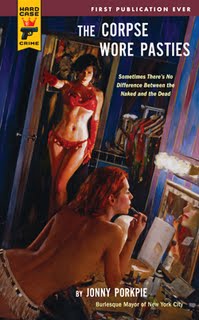 First things first. Is that a cover or what? Nice work by artist Ricky Mujica.
First things first. Is that a cover or what? Nice work by artist Ricky Mujica.
Second things second. I won an advance copy of this book, which will be published late next month, in a Hard Case Crime contest on Twitter. That should keep those FTC bastards off my back.
Jonny Porkpie – I will now go all New York Times and refer to him as Mr. Porkpie – is the burlesque mayor of New York City. This is a self-appointed position, and had I known that I would have claimed it. Therefore, I now declare myself to be the burlesque comptroller of New York City. Wait ‘til you see my ledger bit. Classic.
The book opens with a letter from Mr. Porkpie to Hard Case impresario Charles Ardai, explaining that everything that follows is true. That’s right, Mr. Porkpie is the detective in his own novel. He’s running a burlesque show when one of the performers, known and loathed for stealing other people’s acts, is murdered onstage. The police view Mr. Porkpie as the prime suspect, and thus is he forced to hopscotch around two of the five boroughs interviewing women in various states of undress in order to clear his good stage name.
Mr. Porkpie keeps the action rat-a-tatting along with hoary old jokes, comparing everything to either a G-string or an overstuffed corset. The plot is as thin as a dancer’s veil, but that’s not why you’re reading this book. It’s a lark, and a fun one, with Mr. Porkpie getting into and out of silly, sexy trouble. But not too sexy; Mr. Porkpie is happily married to burlesque performer Nasty Canasta – one of the cover models, FYI – and their relationship is the best thing in the book.
TCM recently aired the oddball burlesque musical Ladies of the Chorus as part of their salute to director Phil Karlson. Marilyn Monroe is one of the titular gamines, working the line alongside her own mother (Adele Jergens, all of nine years older than her screen daughter). Marilyn bumps and grinds her way to the top of the circuit, and a rich boy from Cleveland falls in love with her. Adele tries to kibosh their nuptials, knowing that society types won’t cotton to one of their own wedding a ... burlesque queen.
There’s virtually no conflict in the movie. It’s like the plot of a social hygiene short – Burly-Q&A – padded to (almost) feature length. On the plus side, there’s a character named Bubbles and another who delivers her sole line – “Awww, shut up” – repeatedly. The entire movie is on YouTube, as are individual numbers like the bizarre “Every Baby Needs a Da-Da-Daddy.” The visual quality is poor, so I won’t embed it. But I will link to it.
Tuesday, October 06, 2009
Miscellaneous: New York State of Mind
Two days after my vacation in NYC and I’m already back in the maelstrom, so I’ll keep this recap brief.
“Music doesn’t come from us. It comes through us. But we’ve got to keep ourselves clean on the inside so it can come through us. And most of us don’t. So that’s on us.”
- Barry Harris, whom we saw in performance with his trio at the Jazz Standard
Dear Citi Field:
I like you. I do. You’re a little impersonal and not at all Mets-centric, but you’ve got charm and the pulled pork sandwiches from Blue Smoke are to die for. I think you’ll grow on me. I wasn’t sold on Caesars Club, though. You know, that private section for the wealthier fans that feels like an international departure lounge and features its own bar and carving station? I was in there when Francoeur hit the two-run shot that gave the Mets the lead over Houston, a lead they’d never give up, and I almost felt like it didn’t happen because I saw it on a big screen TV. We left immediately and were back freezing out tuchuses off in the bleachers when Murphy went yard. At least we got to the see the Apple come up. I’d complain further but I figure if the team’s good those seats will be impossible for me to afford, so I’m just going to hope for a great season next year. That way, it won’t be a problem.
Best,
Vince
PS. Thanks for keeping Carvel.
Additional recommendations include Coco Before Chanel, the brilliant new Coen Brothers film A Serious Man – if at all possible, see it with a packed house on the Upper West Side on a Saturday after temple, when it plays like Blazing Saddles – and Mike’s NYC tour of the Fashion District.
You would not think that a cocktail called the New Jersey Turnpike would be good. You would be wrong. Thanks to the bartenders at Little Branch for introducing me to this rye and applejack sour. Also recommended: anything poured at the Flatiron Lounge.
Three days after we saw and enjoyed the Manhattan Theatre Club’s revival of the George S. Kaufman/Edna Ferber play The Royal Family, actor Tony Roberts took ill onstage. We’re glad to hear he’s doing better, and we wish him a swift recovery.
My Flickr page includes additional photos from our walk along the High Line as well as our visit to various locations from Flight of the Conchords.
Friday, September 25, 2009
Movies: Programming Reminders
An alert to all noir fans. Turner Classic Movies is turning over its primetime line-up this evening to the work of director Phil Karlson. After kicking around Hollywood for years in a variety of roles including gag writer for Buster Keaton, Karlson made his reputation in the 1950s with a series of hard-hitting crime dramas.
TCM leads off with Scandal Sheet, based on a novel by Sam Fuller. It’s a wild one. I saw it earlier this year at Noir City. Next up is The Phenix City Story, a brutal small-town exposé that pulls no punches. The night wraps up with the gangster drama The Brothers Rico and the burlesque musical Ladies of the Chorus, featuring an early performance by Marilyn Monroe. Karlson Fest begins at 8PM Eastern, 5PM Pacific.
While I’m at it, I’ll also point out that on Monday, October 5 TCM has scheduled a mini-marathon of films from The Whistler series starting at 6AM Eastern, 3AM Pacific. Sadly, only six of the eight titles will air, with two of the better entries – Mark of The Whistler and The 13th Hour – going missing. Still, it’s a rare chance to see these odd, haunting movies on TV. Set those DVRs.
For more on the Whistler films, read my pointlessly exhaustive coverage.
Wednesday, September 23, 2009
Movies: Shadows of The Thin Man
Quick – who kills who in The Thin Man?
Yeah, I never remember either. That’s not Dashiell Hammett’s fault. As two recent Mystery*File pieces observe, the plot is certainly solid enough. But it’s the barrage of booze-fueled badinage between Nick and Nora Charles, played in the 1934 film and its five sequels by William Powell and Myrna Loy, that gives the story its kick.
The blend of comedy, mystery and romance developed by Hammett proved so successful that plenty of similar movies were made. Without planning to – I don’t really plan anything – I recently watched three of them.
The Ex-Mrs. Bradford (1936) tries to recapture the Thin Man magic in the most obvious way by casting Powell as a society doctor who has split from mystery writer spouse Jean Arthur. There’s still clearly a spark between them, and it’s fanned when Powell is implicated in a race track murder.
Bradford, alas, is a dud; in the interests of full disclosure, I confess to liberal use of the fast-forward button, mainly to get to a wrap-up that makes up in ingenuity what it lacks in plausibility. Part of my problem is that I’m not really a Jean Arthur fan. When I see her I think she’s Gracie Allen, and when I realize my mistake I am invariably disappointed. The movie does feature Eric Blore in one of his 77 performances as a butler. Only 49 more to go.
1938’s The Mad Miss Manton teamed up Barbara Stanwyck and Henry Fonda three years before their legendary pairing in The Lady Eve. Stanwyck plays the proto-Paris Hilton, a socialite and leader of the “Park Avenue Pranksters” regularly derided as frivolous in the press. When she claims to have discovered a dead body that then disappears, newspaper editor Fonda makes it his mission to discredit her. The plot barely hangs together, but at least amateur sleuth Stanwyck makes her share of mistakes. The sight of seven women in furs blundering around crime scenes has its own rewards. For a frothy movie it has a dark palette, no surprise considering that it was filmed by future noir master Nicholas Musuraca. His photography adds some genuine menace to a subway-set climax.
The Princess Comes Across (1936) strikes the perfect balance of elements. Carole Lombard plays the title role, a member of Swedish royalty bound on a cruise ship for her Hollywood debut. Also on board is womanizing bandleader Fred MacMurray (he sings!), a blackmailer, an escaped murderer, and a quintet of internationally renowned detectives (including Sig Ruman and Mischa Auer). Lombard sends up Greta Garbo beautifully, particularly once it’s revealed early on that Princess Olga is actually Brooklyn’s own Wanda Nash, desperate for a break.
I’m kicking myself for missing another example of the form, 1938’s There’s Always A Woman, with Melvyn Douglas and Chez K favorite Joan Blondell from a story by Manton’s Wilson Collison. Ed Gorman and Ivan at Thrilling Days of Yesteryear recommend it, which means I’ll scour the TCM listings for the next airing.
Sunday, September 20, 2009
Miscellaneous: All Thumbs Up
Making up for the paucity of recent posts with a slew of recommendations.
Noir City Sentinel. The latest issue of the house rag of the Film Noir Foundation is now available. This edition has several articles on director André de Toth, a roundup of some recent noir films, an appraisal of actor/wild man Timothy Carey, and more. Go. Give. Get.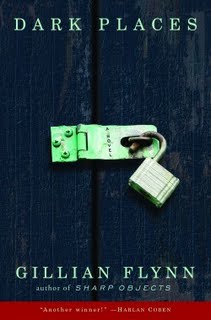 Dark Places, by Gillian Flynn (2009). Libby Day is the sole survivor of the “Satan Sacrifice of Kinnakee, Kansas,” and it’s her testimony that sent her metal-obsessed brother Ben to prison for butchering their mother and two sisters. More than twenty years later, Libby has milked the tragedy dry. Desperate for cash, she agrees to investigate the murder on behalf of the Kill Club, a group of obsessives certain she got everything wrong.
Dark Places, by Gillian Flynn (2009). Libby Day is the sole survivor of the “Satan Sacrifice of Kinnakee, Kansas,” and it’s her testimony that sent her metal-obsessed brother Ben to prison for butchering their mother and two sisters. More than twenty years later, Libby has milked the tragedy dry. Desperate for cash, she agrees to investigate the murder on behalf of the Kill Club, a group of obsessives certain she got everything wrong.
Some of the final plot turns strain credulity, and Flynn has a thing for coining hyphenated words. On a single page, Libby trance-drives past dusk-black elevators that she views with kitten-round eyes. This koala-cute authorial tic can be cough-syrup-cloying, but it’s a small price to pay for a supple voice that bounces between past, present and three distinctly different viewpoints to tell a haunting story of lives teetering on the precipice of disaster long before any blood is shed.
The Ancient Rain, by Domenic Stansberry (2008). An elegiac Shamus Award nominee. Ex-cop and ex-spook Dante Mancuso is drawn into an investigation of a 1970s bank robbery staged by political activists, reawakened by and filtered through the paranoia of the months after September 11. Stansberry nails the mood of 2002 perfectly, as well as Dante’s sense of bearing witness to the slow-motion demise of San Francisco’s Italian community. The Jerusalem File, by Joel Stone (2009). Europa Editions delivers again, with this posthumous novel by Pulitzer Prize nominee Stone. Retired Israeli state security agent Levin finds himself working as a private investigator when a sort-of friend asks him to shadow the wife he’s sure is being unfaithful. Again, the voice is the draw here, combining the world-weariness of Le Carré with the vinegar of Simenon. Or, to put it another way, it’s a tale told by God if He were in fact George Sanders. (For the record, that’s a universe I want to live in.) This brief novel is one of the best of the year.
The Jerusalem File, by Joel Stone (2009). Europa Editions delivers again, with this posthumous novel by Pulitzer Prize nominee Stone. Retired Israeli state security agent Levin finds himself working as a private investigator when a sort-of friend asks him to shadow the wife he’s sure is being unfaithful. Again, the voice is the draw here, combining the world-weariness of Le Carré with the vinegar of Simenon. Or, to put it another way, it’s a tale told by God if He were in fact George Sanders. (For the record, that’s a universe I want to live in.) This brief novel is one of the best of the year.
The Informant!, (2009). Proof that Hollywood does sometimes get it right. When I read Kurt Eichenwald’s book, I felt that he didn’t grasp how truly bizarre – and funny – the material was. But Steven Soderbergh, writer Scott Z. Burns and company certainly do, nailing a tricky tone from the outset. Burns’ adaptation is a marvel, deploying voiceover to great effect and paying it off at the end. Extra points for the score by Marvin Hamlisch, the pride of Queens College.